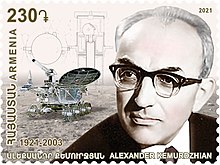Career
In 1951 Kemurdzhian began working at the Leningrad-based All-Union Scientific-Research Institute No. 100 (VNII-100, now known as VNIITransmash), whose "primary expertise was building tanks for the Soviet Army." Kemurdzhian's research focused on continuously variable transmission in tracked vehicles. In 1957 he defended his kandidat nauk thesis. From 1959 on Kemurdzhian led research on air-cushion vehicles (hovercraft).
Kemurdzhian authored 200 scientific publications (mostly papers, some six monographs) and patented 50 inventions.
Work on lunar rovers
Between 1963 and 1973 Kemurdzhian headed the team assigned to develop the chassis for the Lunokhod programme. His team designed both Lunokhod 1 (1970) and Lunokhod 2 (1973). In 1969 he was named deputy director and chief designer at VNIITransmash. Under his leadership, the institute became a leader of space transport engineering. In 1971 he became Doctor of Technical Sciences after defending his dissertation based on his work on Lunokhod 1. He was named professor in 1977.
Kemurdzhian was personally interested in spaceflight and "remote-controlled space probes," which was known to Sergei Korolev. In September 1963 Korolev met with VNIITransmash engineers to discuss the possibilities of developing lunar rovers. The design sketches for the first lunar rover were completed by September 1965. Kemurdzhian provided the main report on the possibility of creating the lunar rover. Georgy Babakin, director of OKB Lavochkin, and Kemurdzhian worked closely to design the Ye-8 in 1966. In 1967 a final lunar rover design was reached and a prototype was constructed. Early models were sent to the moon on Luna 11, Luna 12 (1966) and Luna 14 (1968). Lunokhod 1, the finalized version, was designed by Kemurdzhian and Babakin. Kemurdzhian is credited with being the chief designer of the self-propelled chassis of Lunokhod-1.
Lunokhod 1 was carried to the moon by Luna 17, which was launched on 10 November and landed on the moon on 17 November 1970. It was the "first successful rover to operate beyond Earth" and the "first self-propelled, crewless vehicle to operate on the moon." It weighed 756 kg (1,667 lb) and was 4.42 m (14.5 ft) long and 1.92 m (6 ft 4 in) high. It carried cameras, transmitters and scientific instruments. The remote-controlled robot traveled some 10.54 km (6.55 mi) in 10 months and sent back some 20,000 photos and 200 panoramas. It also completed over 500 lunar soil tests.
Work on Mars lander vehicle
The M71 landers—Mars 2 and Mars 3—which were launched in 1971, both carried a small walking robot called PrOP-M (ПрОП-М, Pribor otsenki prokhodimosti – Mars, "Passability Estimating Vehicle for Mars") developed by Kemurdzian at VNIITransmash.
